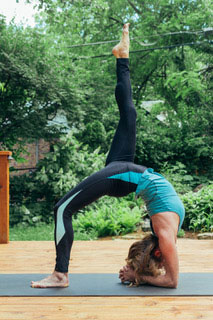
By Jan Herzog
I have been teaching and training in yoga for over 30 years. I have personally benefited immensely. I have taught countless students that have reported reduced pain and stress and increased happiness and joy. Many are now accomplished teachers themselves.
Since yoga has gotten so popular since I started teaching in 1997, I also now hear people declare “yoga helps me develop muscles”, “it calms my nerves”, or “ I can’t do yoga because I’m not flexible enough” Is yoga just contorting your body into weird shapes? Is yoga just relaxing, stretchy? What about all those words and concepts in another language?
The language of yoga is Sanskrit, which is from the same place yoga originated: yep- you knew that- India. The yoga we “do” now is sometimes called modern yoga. For the last 150 years, modern yoga has mostly been known as practicing positions (postures, or asana), movement (vinyasa) and breath (pranayama). The term “yoga” historically means something more like a type of philosophy in Indian history.
Back 500- 2,000 years ago, in India yoga mythologies and philosophies were already evolving and spinning off into entire lineages and traditions. The Bhagavad Gita (means song of the blessed one), the most known reference (and some would say sacred text) of yoga philosophy has been interpreted dozens of different ways. Even within this ancient, beautiful and still relevant story, concepts about various philosophies of yoga are argued.
One of the most direct translations of the word Yoga is “ to join”, or “to join with, for the cause of something”. “Yoga” or “classical yoga” is also a distinct Indian philosophy related to, but distinct from some others that have historically coexisted in India: Buddhism, Tantra (and its numerous aspects), Goddess mythology, Vedanta, Jainism and more. It follows the teachings of Pantajali’s Yoga Sutras, which were “written” over 1,000 years ago. Generally Patangali’s Yoga Sutras teach details about meditation and about lifestyle choices.
During the last 1,000 years, the chronology and history of Indian philosophies are intertwined and complex. Very few involved the yoga poses (asana) and movements (vinyasa or ashtanga flow) we now recognize in a yoga class. They all share an emphasis on realizing a peaceful, focused and calm inner center, among many other things. Many traditions detail breath (pranayama) practice early on in their history as well as much detail about very specific mediation practices, lifestyle choices- both personal and societal, and mental/emotional health practices. The other traditions mentioned above are also now woven into modern yoga. With the exception of an ancient booklet on asana illustrations, there is little evidence of physical exercise in yoga before the early 20th century.
Asana historically means how “to sit” in your meditation “posture”. In colonial India in the early 20th century, schools popularized athletic yoga in gym class. In the 1920’s through the 1950’s Indian spiritual yoga teachers also began to specialize in physical yoga as therapeutic. It can be compared today to seeing a physical therapist or a holistic personal trainer. Eventually, those teachers developed entire systems of physical yoga and they usually aligned with one of the big philosophical lineages or mixed some together.
As Americans and western Europeans traveled to India in the 60’s and 70’s for spiritual journeys they came back home and became teachers or brought their teachers (gurus) for tours. Some taught just mediation or chanting; called kirtan (singing Sanskrit songs call and response); some was physical yoga. Over the last 70 years in the US and in Europe (physical) yoga has diverged into several main categories: Therapeutic- Iyengar Yoga, Relaxing – many styles, Strengthening and Movement based vinyasa, and combinations of these- Sivananda, Dynamic, etc. Many yoga organizations and corporations have now built specific definitions for their style of yoga. Much yoga in your typical gym or yoga studio now is a mixture of very similar movements and positions and “light”
Indian philosophy.
With many yoga styles and teachers here in St. Louis to choose from, you can enjoy yoga for specific goals, to have a certain spiritual experience, for personal preference, or even for a fun date out.
When picking a class or teacher, I like to research who the teacher’s teacher is and research what training the teacher has in adjusting the yoga class for your specific needs. If you have pain or injury, talk with your health care provider before you start yoga or start again, or make an appointment with one of St. Louis’ amazing physical therapists. Once you are cleared for yoga- find a class or a teacher for private sessions and start enjoying the amazing benefits!
For more information contact Jan Herzog, 314-323-1990 or email janherzog3@gmail.com or visit www.janherzogyogaandmassage.com.


